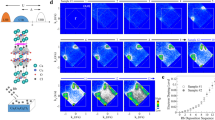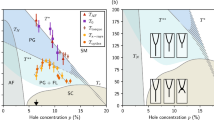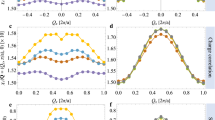Abstract
High-temperature superconductivity in the cuprates is widely believed to originate from an antiferromagnetic parent Mott insulator when doped with charge carriers1. In terms of the electronic structure, the key question is how the large charge transfer gap evolves into the pseudogap and then the d-wave superconducting gap2,3,4,5. However, whether superconductivity or some other symmetry-breaking state (such as charge or spin orders) emerges first on doping a Mott insulator is debatable. To address these issues, here we use scanning tunnelling microscopy to investigate the local electronic structure of lightly doped cuprates in the antiferromagnetic insulating regime. We show that the doped charge induces a spectral weight transfer from the high-energy Hubbard bands to low-energy states within the charge transfer gap. With increasing doping, a V-shaped density-of-state suppression reminiscent of the pseudogap occurs at the Fermi level, which is accompanied by the emergence of chequerboard charge order. Our data suggest that the cuprates first become a charge-ordered insulator on doping, and the Fermi surface and high-temperature superconductivity becomes manifest on further doping.
This is a preview of subscription content, access via your institution
Access options
Subscribe to this journal
Receive 12 print issues and online access
$259.00 per year
only $21.58 per issue
Buy this article
- Purchase on SpringerLink
- Instant access to full article PDF
Prices may be subject to local taxes which are calculated during checkout




Similar content being viewed by others
References
Lee, P. A., Nagaosa, N. & Wen, X.-G. Doping a Mott insulator: physics of high-temperature superconductivity. Rev. Mod. Phys. 78, 17–85 (2006).
Timusk, T. & Statt, B. The pseudogap in high-temperature superconductors: an experimental survey. Rep. Prog. Phys. 62, 61–122 (1999).
Fischer, Ø., Kugler, M., Maggio-Aprile, I., Berthod, C. & Renner, C. Scanning tunneling spectroscopy of high-temperature superconductors. Rev. Mod. Phys. 79, 353–419 (2007).
Hashimoto, M., Vishik, I. M., He, R.-H., Devereaux, T. P. & Shen, Z.-X. Energy gaps in high-transition-temperature cuprate superconductors. Nature Phys. 10, 483–495 (2014).
Anderson, P. W. The resonating valence bond state in La2CuO4 and superconductivity. Science 235, 1196–1198 (1987).
Tranquada, J. M., Sternlieb, B. J., Axe, J. D., Nakamura, Y. & Uchida, S. Evidence for stripe correlations of spins and holes in copper oxide superconductors. Nature 375, 561–563 (1995).
Hoffman, J. E. et al. A four unit cell periodic pattern of quasi-particle states surrounding vortex cores in Bi2Sr2CaCu2O8+δ . Science 295, 466–469 (2002).
Hanaguri, T. et al. A /‘checkerboard/’ electronic crystal state in lightly hole-doped Ca2−xNaxCuO2Cl2 . Nature 430, 1001–1005 (2004).
Vershinin, M. et al. Local ordering in the pseudogap state of the high-Tc superconductor Bi2Sr2CaCu2O8+δ . Science 303, 1995–1998 (2004).
Ghiringhelli, G. et al. Long-range incommensurate charge fluctuations in (Y, Nd)Ba2Cu3O6+x . Science 337, 821–825 (2012).
Comin, R. et al. Charge order driven by Fermi-arc instability in Bi2Sr2−xLaxCuO6+δ . Science 343, 390–392 (2014).
Aeppli, G., Mason, T. E., Hayden, S. M., Mook, H. A. & Kulda, J. Nearly singular magnetic fluctuations in the normal state of a high-Tc cuprate superconductor. Science 278, 1432–1435 (1997).
Lake, B. et al. Spins in the vortices of a high-temperature superconductor. Science 291, 1759–1762 (2001).
Hücker, M. et al. Competing charge, spin, and superconducting orders in underdoped YBa2Cu3Oy . Phys. Rev. B 90, 054514 (2014).
da Silva Neto, E. H. et al. Ubiquitous interplay between charge ordering and high-temperature superconductivity in cuprates. Science 343, 393–396 (2014).
Chang, J. et al. Direct observation of competition between superconductivity and charge density wave order in YBa2Cu3O6.67 . Nature Phys. 8, 871–876 (2012).
Kohsaka, Y. et al. Visualization of the emergence of the pseudogap state and the evolution to superconductivity in a lightly hole-doped Mott insulator. Nature Phys. 8, 534–538 (2012).
Ono, S. & Ando, Y. Evolution of the resistivity anisotropy in Bi2Sr2−xLaxCuO6+δ single crystals for a wide range of hole doping. Phys. Rev. B 67, 104512 (2003).
Kawasaki, S., Lin, C., Kuhns, P. L., Reyes, A. P. & Zheng, G.-q. Carrier-concentration dependence of the pseudogap ground state of superconducting Bi2Sr2−xLaxCuO6+δ revealed by 63,65Cu-nuclear magnetic resonance in very high magnetic fields. Phys. Rev. Lett. 105, 137002 (2010).
Peng, Y. et al. Disappearance of nodal gap across the insulator–superconductor transition in a copper-oxide superconductor. Nature Commun. 4, 2459 (2013).
Ye, C. et al. Visualizing the atomic-scale electronic structure of the Ca2CuO2Cl2 Mott insulator. Nature Commun. 4, 1365 (2013).
Wise, W. D. et al. Imaging nanoscale Fermi-surface variations in an inhomogeneous superconductor. Nature Phys. 5, 213–216 (2009).
Anderson, P. W. & Ong, N. P. Theory of asymmetric tunneling in the cuprate superconductors. J. Phys. Chem. Solids 67, 1–5 (2006).
Randeria, M., Sensarma, R., Trivedi, N. & Zhang, F.-C. Particle-hole asymmetry in doped Mott insulators: implications for tunneling and photoemission spectroscopies. Phys. Rev. Lett. 95, 137001 (2005).
Wise, W. D. et al. Charge-density-wave origin of cuprate checkerboard visualized by scanning tunnelling microscopy. Nature Phys. 4, 696–699 (2008).
Shen, K. M. et al. Nodal quasiparticles and antinodal charge ordering in Ca2−xNaxCuO2Cl2 . Science 307, 901–904 (2005).
He, R.-H. et al. From a single-band metal to a high-temperature superconductor via two thermal phase transitions. Science 331, 1579–1583 (2011).
Tabis, W. et al. Charge order and its connection with Fermi-liquid charge transport in a pristine high-Tc cuprate. Nature Commun. 5, 5875 (2014).
Raichle, M. et al. Highly anisotropic anomaly in the dispersion of the copper-oxygen bond-bending phonon in superconducting YBa2Cu3O7 from inelastic neutron scattering. Phys. Rev. Lett. 107, 177004 (2011).
Le Tacon, M. et al. Inelastic X-ray scattering in YBa2Cu3O6.6 reveals giant phonon anomalies and elastic central peak due to charge-density-wave formation. Nature Phys. 10, 52–58 (2014).
Chen, H.-D., Vafek, O., Yazdani, A. & Zhang, S.-C. Pair density wave in the pseudogap state of high temperature superconductors. Phys. Rev. Lett. 93, 187002 (2004).
Sebastian, S. E. et al. A multi-component Fermi surface in the vortex state of an underdoped high-Tc superconductor. Nature 454, 200–203 (2008).
White, S. R. & Scalapino, D. J. Checkerboard patterns in the t-J model. Phys. Rev. B 70, 220506(R) (2004).
Acknowledgements
We thank T. K. Lee, N. Trivedi, F. Wang, Z. Y. Weng, T. Xiang and G. M. Zhang for helpful discussions. This work is supported by the NSFC and MOST of China (2011CB921703, 2011CBA00110, 2015CB921000), and the Chinese Academy of Sciences (XDB07020300). D.-H.L. was supported by the US Department of Energy, Office of Science, Basic Energy Sciences, Materials Sciences and Engineering Division, grant DE-AC02-05CH11231.
Author information
Authors and Affiliations
Contributions
P.C., W.R., C.Y., X.L. and Z.H. carried out the STM experiments. Y.P. and X.Z. grew the La-Bi2201 single crystals. D.-H.L. provided theoretical analysis. Y.W. designed the project and prepared the manuscript. All authors have read and approved the final version of the manuscript.
Corresponding author
Ethics declarations
Competing interests
The authors declare no competing financial interests.
Supplementary information
Supplementary information
Supplementary information (PDF 1974 kb)
Rights and permissions
About this article
Cite this article
Cai, P., Ruan, W., Peng, Y. et al. Visualizing the evolution from the Mott insulator to a charge-ordered insulator in lightly doped cuprates. Nature Phys 12, 1047–1051 (2016). https://doi.org/10.1038/nphys3840
Received:
Accepted:
Published:
Issue date:
DOI: https://doi.org/10.1038/nphys3840
This article is cited by
-
Strain-induced long-range charge-density wave order in the optimally doped Bi2Sr2−xLaxCuO6 superconductor
Nature Communications (2024)
-
Low-energy gap emerging from confined nematic states in extremely underdoped cuprate superconductors
npj Quantum Materials (2023)
-
The emergence of global phase coherence from local pairing in underdoped cuprates
Nature Physics (2023)
-
Evidence for a spinon Kondo effect in cobalt atoms on single-layer 1T-TaSe2
Nature Physics (2022)
-
Unified energy law for fluctuating density wave orders in cuprate pseudogap phase
Communications Physics (2022)



